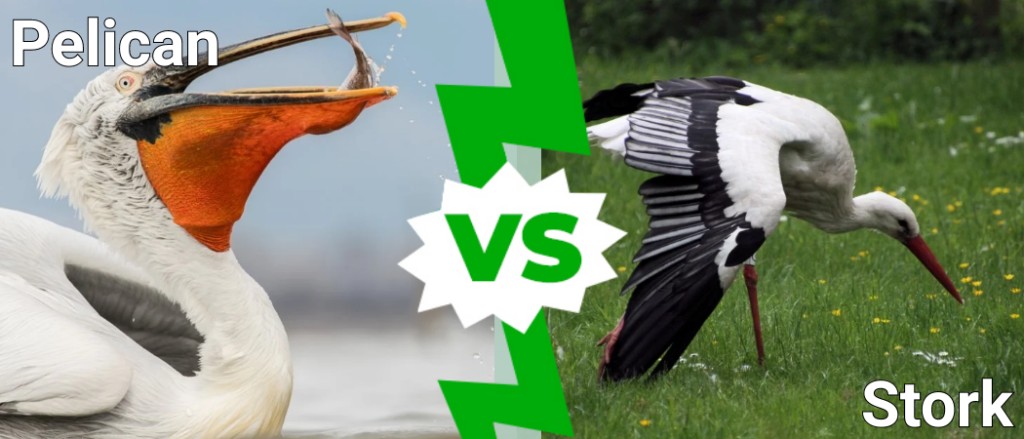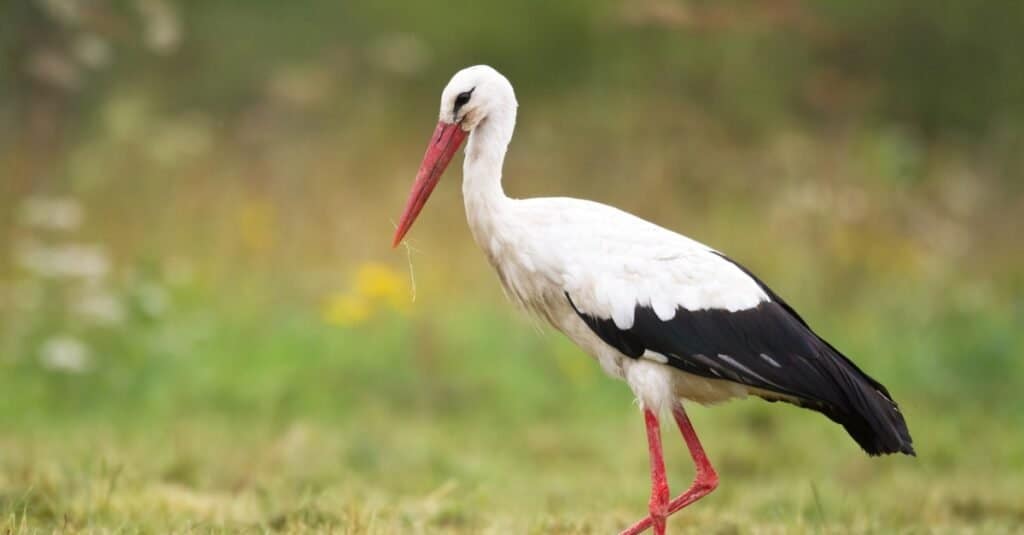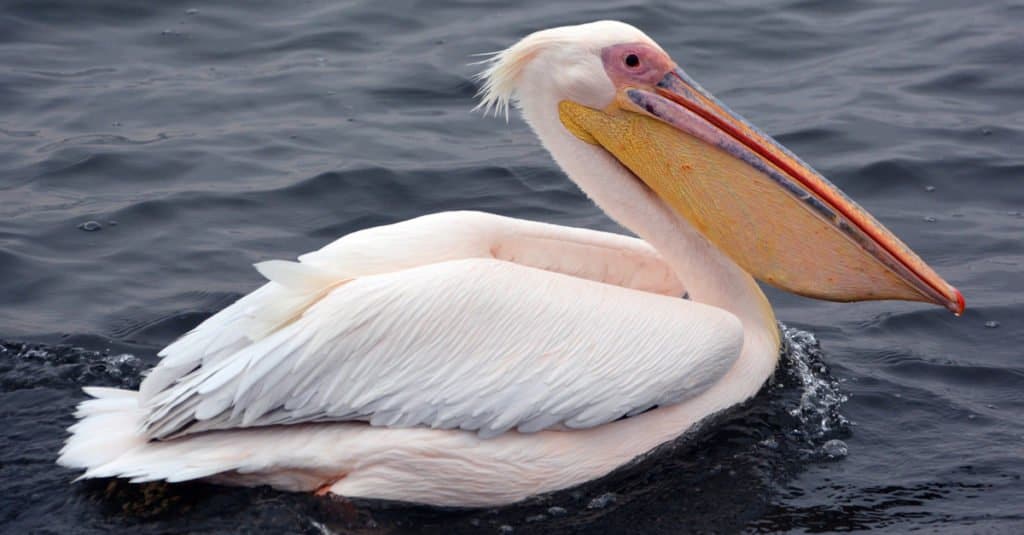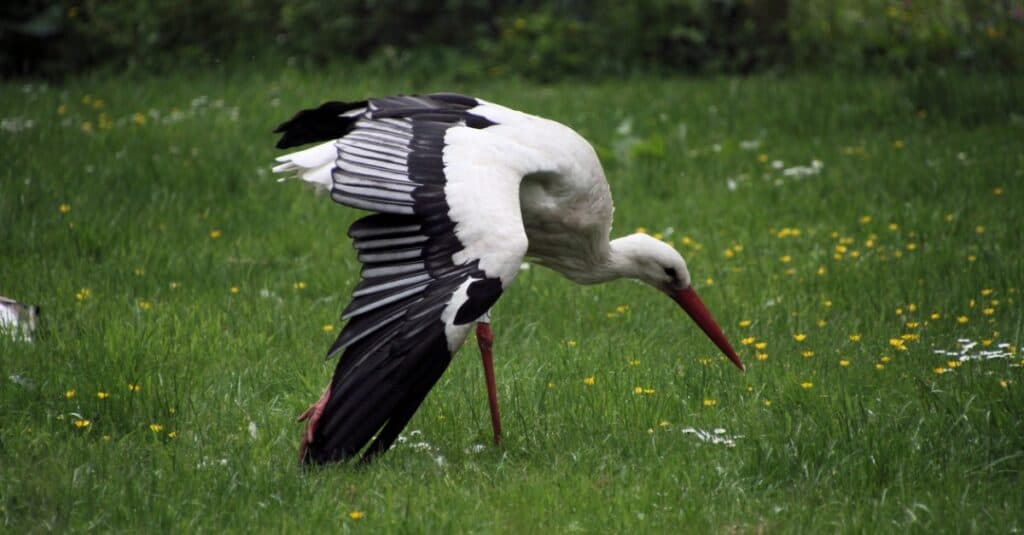Pelicans and storks are somewhat similar animals. They’re known for living near the water, they rest with curved necks, and they have similar colors. So, how can you tell the difference between these birds? We’re going to take a closer look at the pelican vs stork and pick out the most significant differences. They are both unique in various respects; you just need to look a little closer!
Comparing a Pelican and a Stork

The 6 Key Differences Between a Pelican vs Stork

Storks are known for their long legs and long bills.
©Marcin Perkowski/Shutterstock.com
The greatest differences between a pelican and stork include their size, bills, and feet. Pelicans are larger than storks by a rather significant amount. Pelicans can weigh between 9lbs and 30lbs, far greater than the maximum weight of 7.3lbs that a stork can reach.
Aside from their size, the two birds have vastly different bills. The pelican’s bill has a pouch, but the stork’s bill does not. Lastly, their feet are different. Pelicans spend most of their time in the water, so their feet are more webbed than storks. Storks are wading birds; they don’t spend as much time in the water, so their feet only have a small amount of webbing.
These are just a few of the differences between these birds, but a few other notable differences exist.
Pelican vs Stork: Size
One way to tell the difference between a pelican and a stork is to look at their size. Pelicans are usually larger than storks. Pelicans can weigh up to 30lbs and grow 70 inches in length, making them one of the largest birds in North America and other places they live. These are also very tall birds, growing up to 72 inches high!
Storks are smaller, weighing just about 7lbs or a little more, growing up to 42 inches in height, including their long legs, and measuring about 45 inches tall. These are still large birds, but they are noticeably smaller than pelicans when fully grown.
Pelican vs Stork: Bills

Pelicans can store up to 3 gallons of water in their bill pouch!
©meunierd/Shutterstock.com
Another major area of difference between storks and pelicans lies in their bills. Pelicans have larger bills than storks because they integrate a pouch that they use to help catch fish. Some pelicans, like an adult brown pelican will dive down from the air, take in several gallons of water and some prey into their bill, and then drain the water and eat the fish that they caught.
Storks’ bills do not have a large pouch in which to keep their prey. Instead, they wade into the water and use their beaks to snatch prey from the water using precision and speed. Both animals have rather long bills, but the addition of the pouch makes the pelican’s bill much larger.
Pelican vs Stork: Feet
Another major difference between these two birds is their feet. The pelican spends a lot of its time in and around the water. Pelicans’ feet are webbed to help them paddle along the top of the water, much like a duck or other waterfowl. These birds are highly effective swimmers, but they are a little clumsy on the land owing to their short legs and large, flat feet.
Storks have partially webbed feet, but only directly between their toes. They are not nearly as capable of swimming as pelicans. However, storks are not truly water birds in the same sense as pelicans. They are waders, and that means they spend a lot of time around water, but they don’t spend much time swimming. They’ll pluck a meal from the water, but they’re not known for swimming long distances.
Pelican vs Stork: Leg Length
Pelicans have shorter but thicker legs compared to the stork. Their legs are designed to help them swim since they are wide and end in webbed feet. The stork’s legs are very long and thin. They allow the bird to wade out into the water where it can find prey while getting a good view of the area.
Although some storks and pelicans can have similar heights, a great deal of the stork’s height comes from its legs. That partially explains the disparity in weight relative to the birds’ height.
Pelican vs Stork: Standing Behavior

Storks will often rest on one leg while using their long beak to search for food.
©iStock.com/Simon11uk
Pelicans stand on two legs, but storks stand on one leg quite often, especially when they are in a body of water hunting for food. Storks might stand on one leg for many reasons, but the most frequently accepted justification is that they are trying to regulate their temperatures.
Standing on one leg in the water rather than both ensures that the stork loses less body heat than if it had both feet placed in the water. Pelicans can stand on one foot, but they are far more likely to spend time actively swimming like waterfowl.
Pelican vs Stork: Relationship to Water
Pelicans are water birds and storks are wading birds. Although the difference might seem small, this means pelicans spend more time in water compared to storks. Pelicans are built for hunting and swimming in the water, and they can hunt for food while far off the coast of land.
Storks are wading birds, and they usually stand in water and ambush their food by using a variety of means, including moving their bills through the water until they find prey. They spend more of their time in shallow water than in deep water, so they can stand in the water and hunt for small fish and other prey.
Storks and pelicans are both birds that spend a lot of their time in the water. However, pelicans are much larger animals than storks. Also, they possess a pouch on the bottom of their bills and have webbed feet, two attributes that the stork lacks. However, the stork is intriguing and unique, too. This wading bird has an interesting means of hunting and is noteworthy for its long bill and similarity to other birds, like flamingos, that stand on one leg.
The photo featured at the top of this post is © MZPHOTO.CZ/Shutterstock.com
Thank you for reading! Have some feedback for us? Contact the AZ Animals editorial team.






